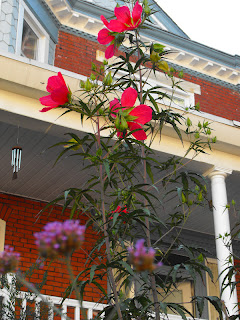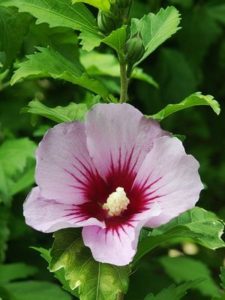I had always thought that the Rose of Sharon was a type of Hibiscus (Hibiscus syriacus, to be exact). A visit to most garden centers will confirm this, though the hibiscus in question eponymously, and quite erroneously, attributes its origins to Syria when in fact it hails from East Asia (and is in fact the national flower of South Korea).
But Rose of Sharon, I have learned, also refers to Hypericum calycinum, better known as St. John's Wort, which of course bears no resemblance or filial relation to the hibiscus.
So we have two different plants with the same common name. Curious, isn't it?
Sort of, but not really, because Rose of Sharon also has come to be attached to a crocus (this is confirmed as a mistranslation of the Hebrew כרכום, karkōm, which grew on the plains of Sharon along the Mediterranean Sea in what is today northern Israel). Confusion may have stemmed from the fact that the crocus bears some resemblance to a previously unidentified, onion-like flowering bulb, Chavatzelet HaSharon, חבצלת השרון, which has been authoritatively identified as Pancratium maritimum, a.k.a. Sand Lily or Sand Daffodil, pictured below.
And the name has been attached to a type of tulip.
And to a type of lily.
Confusion is nothing new.
This is why I try to learn the formal botanical (Latin) names for plants: because their common names mislead.
But then so too do the Latin names, as knowledge becomes more precise, and as knowledge is created.
 I do not have the Rose of Sharon, but I do have Rose Mallow in my garden. I've written about her several times; she is a stunning addition to any garden, and responds well to being accorded a place of prominence where she is permitted to be the belle of the ball.
I do not have the Rose of Sharon, but I do have Rose Mallow in my garden. I've written about her several times; she is a stunning addition to any garden, and responds well to being accorded a place of prominence where she is permitted to be the belle of the ball.(For comparison: I spied a Rose Mallow in the Chanticleer Pond Garden [toward the upper left of the photograph], but it rather gets lost. This is not a point of criticism, for Chanticleer is designed as an Impressionistic tapestry, each plant prominent only for its placement in and contribution to a wider order, a punctuation of color and texture; in the small garden, plants must be selected that both contribute to a wider order and that stand alone as exemplars of a moment or a vision.)
My friend and neighbor, Sharon, loved my Rose Mallow. In fact, she wanted it after we began her garden.
For a moment, I choked. How could I tell her that while Rose Mallow is surprisingly unfussy, she is the botanical equivalent of a bibber, our summer drinks on the porch notwithstanding? And my Sharon made it quite clear she needed low maintenance plants because she had a self-professed "black thumb."
I responded that I'd be happy to divide her once she became acclimated, but that she needed copious amounts of water.
 And out came classic Sharon: "Girrrrlllllll.....you'd best keep her over there so I can look at her pretty! You be bothered, but I can't be. Just as well: I can look out at her everyday, so keep her growing. I get all the pretty and you all the work!"
And out came classic Sharon: "Girrrrlllllll.....you'd best keep her over there so I can look at her pretty! You be bothered, but I can't be. Just as well: I can look out at her everyday, so keep her growing. I get all the pretty and you all the work!"And we laughed.
Last year, Rose Mallow reached approximately 12 feet with five stalks. This year, she sports seven stalks, at approximately the same height. And oh, the flowers she produces!
Our Sharon, our beautiful Sharon, took her leave late yesterday from this earthly existence. She...died. (Take note: how powerful are our words, but more so the tenses of our verbs.) She took her enormous heart, and her infinite goodness, out into other worlds.
 And so my Rose Mallow becomes my inadvertent Rose of Sharon. Perhaps this is how these common names come to refer to a wide variety of plants: our proclivities and personal experiences, our understandings and our misunderstandings, shape our perceptions and we locate, create, linkages between otherwise disparate items. These common names create order where there was none, provide comfort and assurance in a world of uncertainty and confusion.
And so my Rose Mallow becomes my inadvertent Rose of Sharon. Perhaps this is how these common names come to refer to a wide variety of plants: our proclivities and personal experiences, our understandings and our misunderstandings, shape our perceptions and we locate, create, linkages between otherwise disparate items. These common names create order where there was none, provide comfort and assurance in a world of uncertainty and confusion.Genesis: the beginning. A beginning. Naming: Adam's contribution to that beginning. And where there are no names, or when names are altered at will for self-benefit, or when names lose their meaning...well, we need only think of Thucydides' account of the stasis at Corcyra to understand the peril the befalls us.
 We all felt bereft last night, huddled together, remembering and laughing and sharing stories: our mortal way to grasp onto ethereal meaning. We have to reiterate names, name names, ascribe meaning and importance to them all over again...lest we lose them too. That is what we humans do: we attempt to regularize and stabilize; some might call this an exercise of proprietorship, but that misses the mark. We are all mortal in an immortal world. We seek a continuity otherwise lost to us ephemeral beings.
We all felt bereft last night, huddled together, remembering and laughing and sharing stories: our mortal way to grasp onto ethereal meaning. We have to reiterate names, name names, ascribe meaning and importance to them all over again...lest we lose them too. That is what we humans do: we attempt to regularize and stabilize; some might call this an exercise of proprietorship, but that misses the mark. We are all mortal in an immortal world. We seek a continuity otherwise lost to us ephemeral beings.For me, Sharon--the woman, the name--will always be synonymous with strength and fortitude, not just of physicality, but of character and spirit. She did not tolerate intolerance or bigotry, rudeness or shenanigans. She rose above the fray and taught all of us, in her no-nonsense, genuine, and always sassy kind of way, how to be human.
She was a beacon of light, just as Rose Mallow is a mid- to late-summer floral beacon on our block.

Now, Rose Mallow stands alone, bereft of that other rose in our lives.
Rose Mallow extends into the sky, stretching forth, always there, a beacon, to guide the spirit of Sharon back to the place of her earthly life.
** In memory of our beloved Sharon Thompson **



Thank you very much for coming and joining the garden party. The photograph of you and your flowers are beautiful! I love the pictures of her husband made and will be beautiful when the flowers grow and fill the space.
ReplyDeletePrivet Shrub Varieties